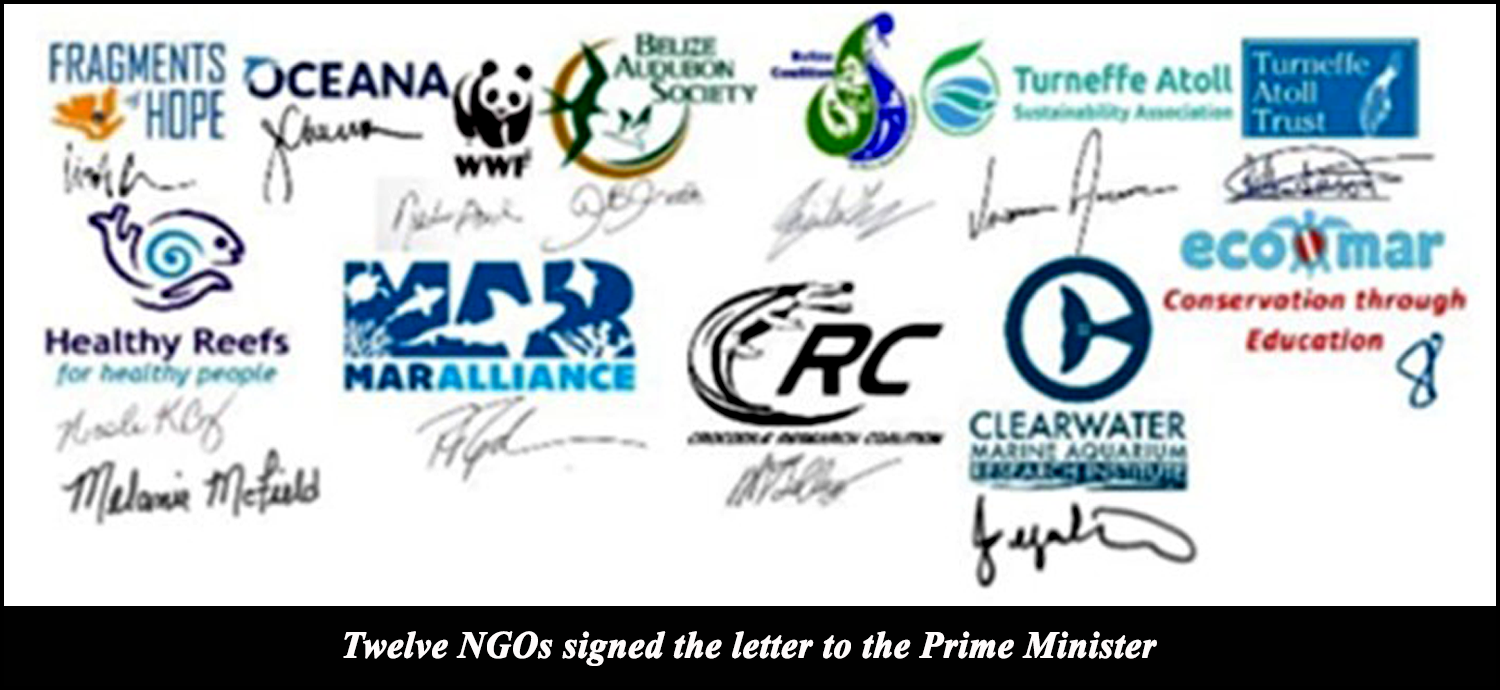Twelve NGOs, including OCEANA, Fragments of Hope, and the Belize Audubon Society, have signed a letter requesting that all EIAs be put on pause until environmental laws are properly amended and enacted.
by Khaila Gentle
BELIZE CITY, Fri. Aug. 26, 2022
A group of conservation NGOs in Belize has written to the Prime Minister requesting that all Environmental Impact Assessments (EIAs) currently in progress be put on pause. This includes the hosting of public consultations. Readers of Amandala will note that one public consultation scheduled to occur soon is a session to be held in regard to the Waterloo Investment Holdings’ proposed Port of Belize Cruise Tourism Facility and Cargo Expansion project—set for this Thursday, September 1.
The purpose of the letter, signed by a total of twelve organizations, is to ensure that the Government is not compromising commitments made under the Blue Bond loan agreement (signed with The Nature Conservancy) by carrying out EIAs before relevant environmental laws and regulations are amended and fully enacted.
“That has been the mantra of the NGO community for a long time—that if we have the systems in place and we have the regulations in place and the laws in place then, yes. We create the environment conducive to investments that match our development plan and match our priorities and goals,” said OCEANA Vice President, Janelle Chanona, to the media on Friday.
The NGO community is concerned by public statements that have been made by potential investors which assert that once an EIA is allowed, environmental clearance is guaranteed.
“Current laws are also being interpreted to infer that if the developers can afford to resubmit rejected EIAs, there are no guidelines or limits for repackaging and resubmitting rejected projects,” the letter further states.
Two weeks ago, the Department of the Environment announced that Waterloo Investment Holdings had resubmitted an application for review of its Environmental Impact Assessment and that, as a part of that resubmission, the company would be hosting another public consultation. The announcement, however, raised much public concern.
Waterloo’s Port Expansion Project was rejected by the National Environmental Appraisal Committee (NEAC) in 2021, and public consultations held by the developers received notable opposition. Despite this, the company has been relentless in its efforts to get the proposed project approved, with its chairman, Lord Michael Ashcroft, going as far as threatening legal action against the Government of Belize in a letter leaked last week.
In speaking with the media, the OCEANA Vice President said that one of the main issues with environmental laws as they stand is that there is nothing that specifies what happens after an EIA is rejected. Furthermore, there is nothing detailing what constitutes a new EIA in the case of resubmission.
“We know that the EIA regs have needed to be amended, and updated. For some time now, there are parts of the law that are silent on critical issues. There are parts of the law that need to be clarified, and we’ve gotten to this point after some time has been allowed and we are not seeing those changes,” said Chanona.
In the letter, the NGO community points out that current laws are being interpreted to infer that if developers can afford to resubmit rejected EIAs, then they can do so without limits.
“By this logic, everyone allowed to prepare an EIA can sue the Belizean Government and people if their proposal is rejected and can continue submitting ‘revised’ rejected EIAs indefinitely,” states the letter.
The conservation community refuses to accept any national development agenda that allows such a possibility.
The twelve NGOs also submitted a letter to Waterloo’s Principal Consultant for the Port of Belize Cruise Tourism Facility and Cargo Expansion project, Allan Herrera, of Nextera Environmental and Engineering Consultants. In that letter, the conservation community asks Herrera to clarify how the “new” Environmental and Social Impact Assessment (ESIA) differs from the previously submitted version.
In a letter/statement that has been sent by Herrera to Chanona, he points to an additional part of the document that outlines what he claims is “an environmentally viable alternative to offshore placement” of the dredged material that the project would generate—material which the company initially planned to dispose of off-shore. He then, after referring to the insertion of that alternative disposal method in the document (specifically the use of an “expanded near-shore disposal site within the Project envelope”), refers to updated information that has been inserted in the ESIA in response to specific requests made by the National Environmental Appraisal Committee (NEAC) regarding six final items, which he then listed. These areas of the document which contain additional or updated information include a section on nearshore disposal and its hydrodynamic impact, a new study on flood risk assessment, additional information from a Lands and Survey Department consultation, and the results of a supposed Port Loyola community consultation that the company is now claiming it conducted.
It’s worth noting, however, that Chanona has publicly pooh-poohed the company’s suggestion that nearshore disposal of the dredged material would prevent environmental harm—including possible damage to the Belize Barrier Reef. Last week, she told Jules Vasquez of 7News, “We confirm still to the position that ocean dumping does not and should never make sense for Belize. It is (I’m trying to be kind) a point of fact that offshore dumping and nearshore dumping are both dumping dredge spoils in the Caribbean Sea. You cannot tell me because the water is in front of Belize City versus in front of Turneffe that that is not the Caribbean Sea. You are talking about dumping millions of cubic meters of dredge spoils in the Caribbean Sea and all the science, all the data has shown, all the modeling has shown, that wherever you dump that material, it will end up on some part of the Belize Barrier Reef System.”

